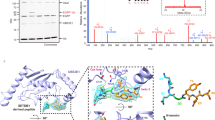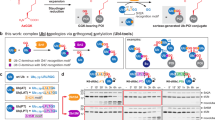Abstract
Ubiquitination is a reversible post-translational modification that regulates a myriad of eukaryotic functions. Our ability to study the effects of ubiquitination is often limited by the inaccessibility of homogeneously ubiquitinated proteins. In particular, elucidating the roles of the so-called 'atypical' ubiquitin chains (chains other than Lys48- or Lys63-linked ubiquitin), which account for a large fraction of ubiquitin polymers, is challenging because the enzymes for their biosynthesis are unknown. Here we combine genetic code expansion, intein chemistry and chemoselective ligations to synthesize 'atypical' ubiquitin chains. We solve the crystal structure of Lys6-linked diubiquitin, which is distinct from that of structurally characterized ubiquitin chains, providing a molecular basis for the different biological functions this linkage may regulate. Moreover, we profile a panel containing 10% of the known human deubiquitinases on Lys6- and Lys29-linked ubiquitin and discover that TRABID cleaves the Lys29 linkage 40-fold more efficiently than the Lys63 linkage.
This is a preview of subscription content, access via your institution
Access options
Subscribe to this journal
Receive 12 print issues and online access
$259.00 per year
only $21.58 per issue
Buy this article
- Purchase on Springer Link
- Instant access to full article PDF
Prices may be subject to local taxes which are calculated during checkout




Similar content being viewed by others
References
Chen, Z.J. & Sun, L.J. Nonproteolytic functions of ubiquitin in cell signaling. Mol. Cell 33, 275–286 (2009).
Komander, D. The emerging complexity of protein ubiquitination. Biochem. Soc. Trans. 37, 937–953 (2009).
Ikeda, F. & Dikic, I. Atypical ubiquitin chains: new molecular signals. 'Protein modifications: beyond the usual suspects' review series. EMBO Rep. 9, 536–542 (2008).
Peng, J. et al. A proteomics approach to understanding protein ubiquitination. Nat. Biotechnol. 21, 921–926 (2003).
Xu, P. et al. Quantitative proteomics reveals the function of unconventional ubiquitin chains in proteasomal degradation. Cell 137, 133–145 (2009).
Hershko, A. & Ciechanover, A. The ubiquitin system. Annu. Rev. Biochem. 67, 425–479 (1998).
Komander, D. et al. Molecular discrimination of structurally equivalent Lys 63-linked and linear polyubiquitin chains. EMBO Rep. 10, 466–473 (2009).
Dikic, I., Wakatsuki, S. & Walters, K.J. Ubiquitin-binding domains—from structures to functions. Nat. Rev. Mol. Cell Biol. 10, 659–671 (2009).
Wang, H. et al. Analysis of nondegradative protein ubiquitylation with a monoclonal antibody specific for lysine-63-linked polyubiquitin. Proc. Natl. Acad. Sci. USA 105, 20197–20202 (2008).
Newton, K. et al. Ubiquitin chain editing revealed by polyubiquitin linkage-specific antibodies. Cell 134, 668–678 (2008).
Bremm, A., Freund, S.M.V. & Komander, D. Lys11-linked ubiquitin chains adopt compact conformations and are preferentially hydrolysed by the deubiquitinase Cezanne. Nat. Struct. Mol. Biol. 17, 939–947 (2010).
Chatterjee, C., McGinty, R.K., Pellois, J.-P. & Muir, T.W. Auxiliary-mediated site-specific peptide ubiquitylation. Angew. Chem. Int. Edn Engl. 46, 2814–2818 (2007).
McGinty, R.K., Kim, J., Chatterjee, C., Roeder, R. & Muir, T. Chemically ubiquitylated histone H2B stimulates hDot1L-mediated intranucleosomal methylation. Nature 453, 812–816 (2008).
Yang, R., Pasunooti, K., Li, F., Liu, X. & Liu, C. Dual native chemical ligation at lysine. J. Am. Chem. Soc. 131, 13592–13593 (2009).
Ajish Kumar, K.S., Haj-Yahya, M., Olschewski, D., Lashuel, H.A. & Brik, A. Highly efficient and chemoselective peptide ubiquitylation. Angew. Chem. Int. Edn Engl. 48, 8090–8094 (2009).
Li, X., Fekner, T., Ottesen, J.J. & Chan, M.K. A pyrrolysine analogue for site-specific protein ubiquitination. Angew. Chem. Int. Edn Engl. 48, 9184–9187 (2009).
Hodgins, R.R., Ellison, K.S. & Ellison, M.J. Expression of a ubiquitin derivative that conjugates to protein irreversibly produces phenotypes consistent with a ubiquitin deficiency. J. Biol. Chem. 267, 8807–8812 (1992).
Tran, H., Hamada, F., Schwarz-Romond, T. & Bienz, M. Trabid, a new positive regulator of Wnt-induced transcription with preference for binding and cleaving K63-linked ubiquitin chains. Genes Dev. 22, 528–542 (2008).
Srinivasan, G., James, C.M. & Krzycki, J.A. Pyrrolysine encoded by UAG in Archaea: charging of a UAG-decoding specialized tRNA. Science 296, 1459–1462 (2002).
Ambrogelly, A. et al. Pyrrolysine is not hardwired for cotranslational insertion at UAG codons. Proc. Natl. Acad. Sci. USA 104, 3141–3146 (2007).
Neumann, H., Peak-Chew, S.Y. & Chin, J.W. Genetically encoding N(epsilon)-acetyllysine in recombinant proteins. Nat. Chem. Biol. 4, 232–234 (2008).
Polycarpo, C.R. et al. Pyrrolysine analogues as substrates for pyrrolysyl-tRNA synthetase. FEBS Lett. 580, 6695–6700 (2006).
Kawakami, T. et al. Polypeptide synthesis using an expressed peptide as a building block for condensation with a peptide thioester: application to the synthesis of phosphorylated p21Max protein(1–101). J. Pept. Sci. 7, 474–487 (2001).
Aimoto, S. Polypeptide synthesis by the thioester method. Biopolymers 51, 247–265 (1999).
Tan, Z., Shang, S., Halkina, T., Yuan, Y. & Danishefsky, S.J. Toward homogeneous erythropoietin: non-NCL-based chemical synthesis of the Gln(78)-Arg(166) glycopeptide domain. J. Am. Chem. Soc. 131, 5424–5431 (2009).
Tam, J.P., Heath, W.F. & Merrifield, R.B. Mechanisms for the removal of benzyl protecting groups in synthetic peptides by trifluoromethanesulfonic acid trifluoroacetic-acid dimethyl sulfide. J. Am. Chem. Soc. 8, 5242–5251 (1986).
Pickart, C.M. & Raasi, S. Controlled synthesis of polyubiquitin Chains. Methods Enzymol. 399, 21–36 (2005).
Komander, D., Clague, M.J. & Urbe, S. Breaking the chains: structure and function of the deubiquitinases. Nat. Rev. Mol. Cell Biol. 10, 550–563 (2009).
Fushman, D. & Walker, O. Exploring linkage dependence of polyubiquitin conformations using molecular modeling. J. Mol. Biol. 395, 803–814 (2010).
Wang, T. et al. Evidence for bidentate substrate binding as the basis for the K48 linkage specificity of otubain 1. J. Mol. Biol. 386, 1011–1023 (2009).
Cooper, E.M. et al. K63-specific deubiquitination by two JAMM/MPN+ complexes: BRISC-associated Brcc36 and proteasomal Poh1. EMBO J. 28, 621–631 (2009).
Popp, M.W., Artavanis-Tsakonas, K. & Ploegh, H.L. Substrate filtering by the active site crossover loop in UCHL3 revealed by sortagging and gain-of-function mutations. J. Biol. Chem. 284, 3593–3602 (2009).
Reyes-Turcu, F.E. et al. The ubiquitin binding domain ZnF UBP recognizes the C-terminal diglycine motif of unanchored ubiquitin. Cell 124, 1197–1208 (2006).
Komander, D. et al. The structure of the CYLD USP domain explains its specificity for Lys63-linked polyubiquitin and reveals a B box module. Mol. Cell 29, 451–464 (2008).
McCullough, J., Clague, M.J. & Urbe, S. AMSH is an endosome-associated ubiquitin isopeptidase. J. Cell Biol. 166, 487–492 (2004).
Sato, Y. et al. Structural basis for specific cleavage of Lys 63-linked polyubiquitin chains. Nature 455, 358–362 (2008).
Winborn, B.J. et al. The deubiquitinating enzyme ataxin-3, a polyglutamine disease protein, edits Lys63 linkages in mixed linkage ubiquitin chains. J. Biol. Chem. 283, 26436–26443 (2008).
Komander, D. et al. Molecular discrimination of structurally equivalent Lys 63-linked and linear polyubiquitin chains. EMBO Rep. 10, 466–473 (2009).
Wang, T. et al. Evidence for bidentate substrate binding as the basis for the K48 linkage specificity of otubain 1. J. Mol. Biol. 386, 1011–1023 (2009).
Cooper, E.M., Boeke, J.D. & Cohen, R.E. Specificity of the BRISC deubiquitinating enzyme is not due to selective binding to Lys63-linked polyubiquitin. J. Biol. Chem. 285, 10344–10352 (2010).
Cook, W.J., Jeffrey, L.C., Carson, M., Chen, Z. & Pickart, C.M. Structure of a diubiquitin conjugate and a model for interaction with ubiquitin conjugating enzyme (E2). J. Biol. Chem. 267, 16467–16471 (1992).
Eddins, M.J., Varadan, R., Fushman, D., Pickart, C.M. & Wolberger, C. Crystal structure and solution NMR studies of Lys48-linked tetraubiquitin at neutral pH. J. Mol. Biol. 367, 204–211 (2007).
Wu-Baer, F., Lagrazon, K., Yuan, W. & Baer, R. The BRCA1/BARD1 heterodimer assembles polyubiquitin chains through an unconventional linkage involving lysine residue K6 of ubiquitin. J. Biol. Chem. 278, 34743–34746 (2003).
Nishikawa, H. et al. BRCA1-associated protein 1 interferes with BRCA1/BARD1 RING heterodimer activity. Cancer Res. 69, 111–119 (2009).
Hermanson, G.T. Bioconjugate Techniques 2nd ed. (Academic Press, 2008).
Acknowledgements
We thank K.D. Wilkinson (Emory University), B. Kessler (Oxford University), S. Urbe, M. Clague (Liverpool University) and P. Cohen (MRC Protein Phosphorylation Unit, Dundee) for constructs, S. Peak-Chew, F. Begum and E. Stephens for MS/MS and members of the Laboratory of Molecular Biology for reagents. We thank L. James (Laboratory of Molecular Biology) for suggestions on kinetic analysis. This work was supported by the Medical Research Council, United Kingdom.
Author information
Authors and Affiliations
Contributions
J.W.C. and D.K. initiated the study. J.W.C. and S.V. designed the ubiquitin chain synthesis and developed the quantitative blot method for deubiquitinase kinetics. S.V. implemented and characterized the synthesis with assistance from D.P.N. and implemented and analyzed the quantitative kinetics on TRABID by western blot. S.V. and D.K. performed structural studies, analyzed structural data and designed and analyzed the deubiquitinase screen. Y.Y. and D.K. developed the fluorescent deubiquitinase assay that S.V. applied to estimate the Kms for TRABID. S.V., D.K. and J.W.C. analyzed the data and wrote the paper.
Corresponding authors
Ethics declarations
Competing interests
The authors declare no competing financial interests.
Supplementary information
Supplementary Text and Figures
Supplementary Figures 1–8, Supplementary Table 1 and Supplementary Methods (PDF 2309 kb)
Rights and permissions
About this article
Cite this article
Virdee, S., Ye, Y., Nguyen, D. et al. Engineered diubiquitin synthesis reveals Lys29-isopeptide specificity of an OTU deubiquitinase. Nat Chem Biol 6, 750–757 (2010). https://doi.org/10.1038/nchembio.426
Received:
Accepted:
Published:
Issue Date:
DOI: https://doi.org/10.1038/nchembio.426
This article is cited by
-
Neutron-encoded diubiquitins to profile linkage selectivity of deubiquitinating enzymes
Nature Communications (2023)
-
Reprogramming the genetic code
Nature Reviews Genetics (2021)
-
The role of ubiquitination in tumorigenesis and targeted drug discovery
Signal Transduction and Targeted Therapy (2020)
-
Incorporation of nonstandard amino acids into proteins: principles and applications
World Journal of Microbiology and Biotechnology (2020)
-
Trapping biosynthetic acyl-enzyme intermediates with encoded 2,3-diaminopropionic acid
Nature (2019)



